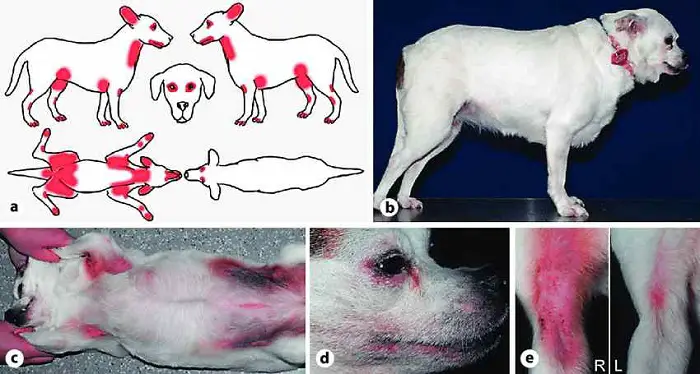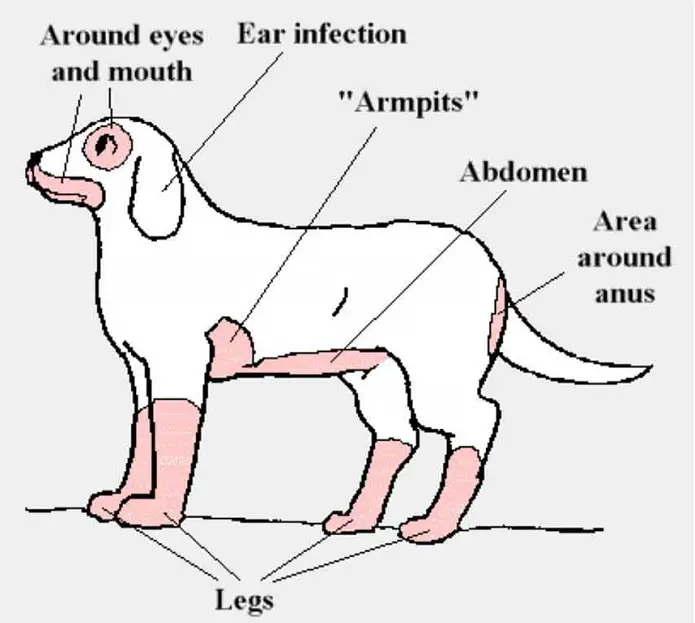Atopic dermatitis or pruritis is an itchy skin disease in dogs and cats. The allergic reaction occurs when the susceptible animal inhales or ingests allergens like pollen or house dust. Canine atopic dermatitis is an inherited tendency to respond to environmental allergens by developing a type I hypersensitivity.
The allergic reaction causes rubbing, itching, biting, licking, or scratching. Unlike humans, pruritis in dogs sometimes causes sneezing, coughing, and asthma.
Causes of Canine Atopic Dermatitis
Atopic dermatitis in dogs results from a genetic predisposition to become sensitized to environmental allergens. Although the route of allergen access is still controversial, inhalation and percutaneous absorption of these allergens seem likely.
- Inhalation of pollen grains.
- House dust.
- Allergic food.
- Contact with itching substances.
- Flea bites.
- Hypersensitive skin.
- Photosensitization reaction.
Clinical Signs and Symptoms Pruritis in Dogs
Atopic dermatitis usually affects young adult dogs at the age of 1-3 years old with seasonal pruritis. It is crucial to discern the presence, intensity, and frequency of itch. The aspect, distribution, and progression of cutaneous lesions, flea eradication programs, and previous treatment and effect. Pruritis should be evident and affect one or more of the following areas:
- Face.
- Extensor and Flexor skin surfaces.
- Axilla.
- Pinna.
- Groin.
The most common clinical symptoms are:
- Excessive itching.
- A papule or pustule formation filled with fluid or pus.
- Hyperkeratinization of kin.
- Alopecia on the affected part of the skin.
- Oozing of fluid or pas from the affected area.
- Restlessness.
Diagnosis of Canine Atopic Dermatitis
Diagnosis of canine atopic dermatitis is based on the following:
- Compatible historical information.
- Specific clinical signs.
- Ruling out the causes of pruritis.
Secondary bacterial diseases may also contribute to the pruritic threshold in the atopic patient, which can be recurrent problems that must be continuously addressed.
- Otitis media or interna.
- Superficial pyoderma.
- Acute moist dermatitis.
- Keratinization disorder.
- Malassezia dermatitis.
- Flea bite hypersensitivity.
- Acral Leak dermatitis.
- Fibropruritic nodules.
Differential Diagnosis of Pruritis in Dogs
The disease must be differentiated from the following diseases:
- Sarcoptic mange.
- Cheyleiellosis.
- Pediculosis.
- Contact allergic dermatitis.
- Food Hypersensitivity.
- Flea bite hypersensitivity.
- Pelodera Strongyloides dermatitis.
- Malassezia dermatitis.
- Superficial pyoderma.
- Xerosis.
Treatment of Canine Atopic Dermatitis
When allergen avoidance is not possible, hyposensitization is the treatment of choice for animals with a long allergy season.
- Hyposensitization is based on in vitro or in vivo allergy testing and effectively decreases pruritis or reduces the need for other medications in 60-80% of dogs.
- The success of hyposensitization may be noted for 3-12 months.
- Symptomatic therapy includes the use of antihistamines and essential fatty acids.
- Topical antipruritis therapy.
- Oral corticosteroids on alternate days.
- Avoidance and as well as managing secondary infections.
Final Talk on Canine Atopic Dermatitis
Pruritis is a common allergic skin disease in dogs and cats. Allergens like pollen, dust, flea bites, and many more cause the disease. The disease manifests in severe itching, pustule formation, oozing, alopecia, and redness. The disease can be treated by antibiotic, antifungal, or antihistamines drugs. The disease can be prevented by maintaining a healthy living and allergen-free environment for your lovely pets.

